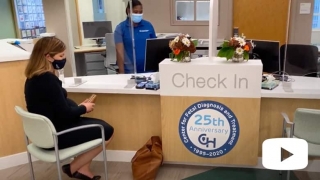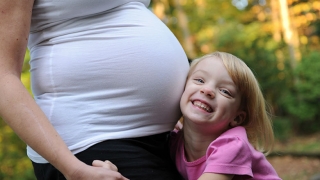When Gayle and Charles Hughes of Woodbury, NJ, became pregnant after several miscarriages, the couple was overjoyed. But after Gayle's obstetrician recommended an advanced ultrasound to monitor the baby she was carrying, their joy turned to alarm.
The baby boy had a giant omphalocele. An omphalocele is a birth defect that causes the abdominal organs to herniate or protrude into the base of the fetus's umbilical cord. The herniation can vary from small — involving only a portion of the small intestine — to very large and involving most of the abdominal organs. When a giant omphalocele is present, the majority of the liver protrudes into the umbilical cord.
The Hughes baby’s omphalocele involved all of his internal abdominal organs: liver intestine and stomach.
Fetuses with omphalocele also are at an increased risk for other birth defects, such as cardiac or neural tube defects, problems involving the intestines or urinary tract, or life threatening chromosome anomalies including Trisomy 18. The local hospital recommended terminating the pregnancy.
"It was a stressful and scary time," Gayle recalls. "We weren't sure that he would survive."
One of CHOP's first fetal patients
 The couple sought help from a new specialty center: the Center for Fetal Diagnosis and Treatment at Children's Hospital of Philadelphia. They became one of the Center's first patients.
The couple sought help from a new specialty center: the Center for Fetal Diagnosis and Treatment at Children's Hospital of Philadelphia. They became one of the Center's first patients.
"The Children's Hospital staff was so reassuring," Gayle says. "They told me they could fix the omphalocele if other conditions could be ruled out."
At the Center, testing was done to evaluate any possible lung, heart or spinal problems. Gayle had a detailed level II ultrasound, an echocardiogram of the fetal heart and an ultrafast fetal MRI. And when the fetal team met with the couple, the news was positive.
The baby's heart was functioning well, no neurological problems were detected, and his spine was developing normally. Further chorionic villus sampling (CVS) indicated the fetus had no chromosomal abnormalities. The only potential problem was that his lungs were small.
The team decided to monitor Gayle closely with weekly ultrasounds throughout the remainder of her pregnancy, and perform surgery to return the herniated organs back into the abdomen after the baby was born.
Born at 38 weeks gestation
Baby Charlie was born at the Hospital of the University of Pennsylvania —next door to CHOP — on Nov. 19, 1996, at 38 weeks gestation. Delivered by a scheduled Cesarean section, he weighed 6 lbs., 4 oz. He was immediately taken to Children's Hospital's Newborn/Infant Intensive Care Unit (N/IICU).
"The hardest part," says Gayle, "was that I only saw him for a second and then had to wait until the next day to see him when I was taken by wheelchair over to Children's Hospital."
She points out that since the opening of CHOP’s Garbose Family Special Delivery Unit in 2008, babies and mothers now stay in the same facility after delivery. “I think one of the best things they ever did was to put the delivery rooms here at CHOP, so the moms could be right there with their children right after they're born,” she notes.
Surgeries to repair omphalocele
Charlie was in the N/IICU for 77 days, and in the first four weeks of his young life he underwent seven surgeries to return the herniated organs to his abdomen. Born with small lungs, he also was on a ventilator for more than a month.
When Gayle recalls the time spent in the N/IICU, she praises the caring professionalism of the nursing staff.
"The nurses were so understanding and highly trained," Gayle says. "Even having such a sick baby, I felt comfortable he was receiving the best possible care."
The doctors also kept the Hughes family informed every step of the way. "We were always told what was going on; we were never left in the dark," she adds.
Going home and early intervention
 When Charlie came home at the end of January, challenges still lay ahead for his parents.
When Charlie came home at the end of January, challenges still lay ahead for his parents.
"Having the omphalocele repaired in the hospital was just the beginning of the process," says Gayle.
Most babies with this defect don't eat well, and Charlie was no exception. He required a feeding tube to provide a high calorie diet. He also was on oxygen for the first year.
Before Charlie came home from the hospital, Children's Hospital staff taught Gayle and Charles how to insert and care for the feeding tube and oxygen. This was just one example of the tremendous chain of support at Children's Hospital, says Gayle, who herself now is a resource for other families with babies with omphalocele. "It makes us all a little smarter and a little less scared."
As Charlie grew, the local school system also provided early intervention services that included physical and occupational therapy and a feeding specialist.
'Miracle boy' continues to excel
Charlie continued to thrive. By age 2, he was eating normally. By age 3, he had finished his intervention programs.
Today, Charlie is finishing up his sophomore year in college where he is studying physics and astronomy. He earned his Eagle Scout rank for Boy Scouts in high school, is a member of the Phi Beta Kappa Society, and hopes to become an astrophysicist after graduate school. This summer he will be doing research in the Physics Department at Rowan University, studying micelles.
His parents call the active 20-year-old their "miracle boy."
“I am healthy and I am extremely thankful for that,” says Charlie. “The people at CHOP are extremely helpful. I wouldn't be who I am today without them.”
Updated: May 2017

